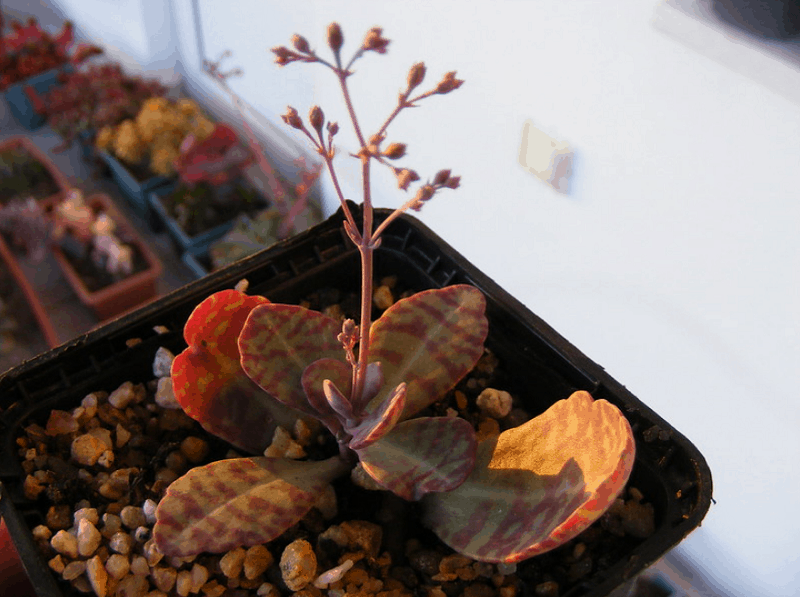Kalanchoe humilis is a small perennial and succulent shrub belonging to the Crassulaceae family and native to the south-east of the African continent.
It grows primarily on rocky substrates near freshwater sources but never on flooded substrates.
It is a plant grown throughout the world as a collection plant due to the beauty of the foliage and its simple cultivation requirements.
Typical leaves of the tabby Kalanchoe, Kalanchoe humilis
Stems
This species usually develops a small central stem of +/- 8 cm in height, slightly branched and slightly lignified at the base.
In greenhouse conditions with quality substrates, this stem can exceed 15 cm in height.
The stems generally have more than 0.5 cm thick and a reddish-green color.
Leaves
The leaves are arranged opposite on the stems and tend to remain fairly compact (one pair over the next).
Each leaf is +/- 10 cm long and +/- 4 cm wide, they are lanceolate or elliptical in shape with the margin created in the mid-terminal region.
All the leaves are clearly fleshy and exhibit a greenish-gray color with numerous reddish-brown spots of great ornamental value.
In all the leaves it is possible to observe a pale green central line. The spots are generally arranged forming horizontal bands. Margins also tend to stain.
In this species, the basal leaves will eventually fall, leaving the base of the stems completely bare.
Flowers
The flowers are grouped numerous into highly branched terminal inflorescences that develop floral stems over 20 cm high.
All flowers are small with pinkish-green petals.
In this species, the flowers are not decorative and that is why many growers cut the inflorescences.
Tips to take care of the Kalanchoe humilis
Kalanchoe humilis is a very easy plant to maintain in the garden. Next, its basic cultivation requirements:
Illumination
It is essential to provide a lot of lighting to avoid the etiolation of the stems.
The leaf spots are accentuated even more under conditions of intense lighting.
It is recommended to expose to the sun in the early hours of the morning and late in the afternoon.
Temperatures
It grows much better under the influence of high temperatures.
The optimum temperature range for the species is between 20ºC-29ºC. It does not tolerate temperatures below 0ºC for long periods.
Substratum
It requires a substrate slightly rich in organic matter and with optimal drainage.
Prolonged waterlogging will quickly rot the radical system. Commercial substrates for crass and cacti can be used without problems with an extra aggregate of coarse sand.
Remember the previous disinfection of the substrate to avoid the proliferation of pathogens that are in it.
Watering
Irrigate preferably after drying the surface of the substrate during hot seasons.
Watering should preferably be done at the height of the substrate to avoid wetting the foliage
Plagues and diseases
Attacked mainly by mealybugs and mollusks.
The mealybugs cause the fall of the leaves, wilting of the flowers and allow the proliferation of pathogenic fungi.
Molluscs devour sections of leaves and stems in a short time.
Multiplication
It is multiplied by cuttings of stems or from leaves.
To propagate Kalanchoe humilis from cuttings, use a sharp, sterile knife or pair of scissors and cut a piece of the plant just above a leaf on the stem. Allow it to dry for a couple of days, and place in well-draining soil.
Kalanchoe humilis will produce small rosette offsets. Cut the offsets off from the main stem with a sharp, sterile knife or scissors. Allow the offsets to dry for one to two days before laying on well-draining soil.
